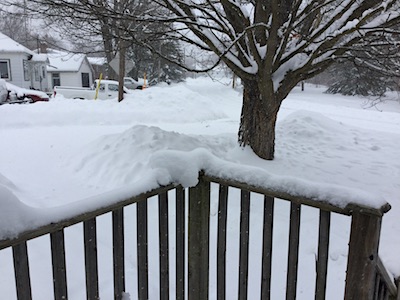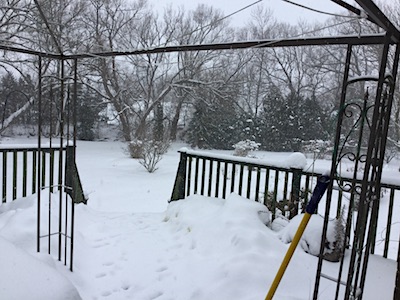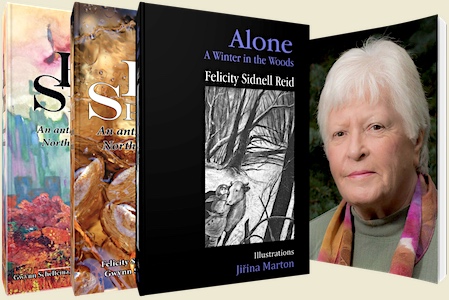
The snow is stacked up around here this winter. And today we may get a further 15 cms, according to one lugubrious forecaster. We are on the edge of a storm dumping even more snow into Lake Ontario and on its southern shores. Not much comfort, as outside my window, toppling battlements turn into barricades and I feel imprisoned in an icy fortress.
Perhaps it’s time for comfort food. This seems to be perfectly acceptable these days; witness the many articles and ads which promote local versions of the same. Though why exactly traditional foods (Wikipedia provides lists specific to 20 different countries and cultures) should be regarded, by many, as an indulgence is a mystery. Foods, like pea soup, tourtiere, and varieties of chicken casserole have long been staples cooked with love and success for hungry families, in local versions across most of the world. The ingredients readily available, easily assembled and the cooking uncomplicated, provided consumers with the strength and cheer they required. Comfort food often plays to nostalgia for our childhood—granny’s cooking; a memory of a safer happier environment in which we thrived.
It’s not surprising that we seek comfort when the world’s problems seem ineradicable, or when our personal experience includes loss and sorrow, hardship and difficult challenges. Indulgent as it may be, we, legitimately, in my opinion, try to balance the terrors, pains and discomforts of the modern world with imaginary constructs or perhaps remembered ones where someone (maybe even oneself) has had the sense to create a place and characters intriguing enough that in the pages of a book we forget, for while, what we cannot change.
For avid readers, comfort reading is as effective as comfort food and probably has fewer negative side effects. It’s unfortunate that critics often disregard those genre writers, who entertain us with romances, mysteries and adventures, and have trouble recognising that fine as well as bad writing can be found in every genre. Plots that are well constructed, characters, that engage our interest and emerge as individuals, not virtuous or villainous puppets, and a setting which contributes both to the atmosphere and action of the story are of crucial importance, whatever the genre. At the root of all long-lasting books is a good story. Listeners/readers have always thrilled to heroes and heroines and monsters, laughed at the absurdities of life and humans, or become engrossed in the stories and struggles of those who tell of their own challenges.
The other day, I enjoyed Jaq D Hawkins post on the Story Reading Ape’s Blog called, “Let’s talk about Romance.” She pointed out we have allowed our definition of romance to become too narrow. “Romance,” she writes, “is well represented in the Classics; Jane Austen, the Bronte sisters, even Shakespeare …and Leo Tolstoy have written popular books that fall into the Romance genre.” And she goes on to suggest that “an element of romance” contributes to the success of all kinds of stories. Considering the contemporary market for “romance”, she writes “there must be some good Romance stories like the kind I used to read.”
Well, I think there are. They may be disguised to some extent as histories, mysteries or fantasy, or a combination of these, but if romance is the leaven of most stories, it’s equally true that it’s the historical, mysterious, fantastic or humorous elements, which give it the substance to endure. It isn’t only the classical romances of Austen etc that have remained available through centuries. The Hobbit and Lord of the Rings are still widely read, the mystery novels of Agatha Christie, Josephine Tey, or Margery Allingham are regularly re-issued and most of the books of historical romance writer Georgette Heyer have never been out of print. In the present day, should we not include the Harry Potter novels in a broader definition of romance?
The cross-over of mystery, history and romance has fuelled the careers of many contemporary authors, Elly Grffiths and Susanna Kearsley for example. We might also include the great naval series by Patrick O’Brian, whose twenty novels about Captain Jack Aubrey and surgeon Stephen Maturin and their adventures fighting against Napoleon are partly held together by the concomitant stories of their efforts to win the women they desire and, later in the series, by the “sea of troubles” which beset those who are separated for long periods from their wives and families.
To return to my comfort theme; here we look for a fictional world, in which the protagonist’s challenges, whether intellectual, emotional or physical, will, in the end, be resolved. The huge popularity of mystery and detective stories, especially those which rely on the careful placement of clues and clever plotting, provides evidence for this. Readers become familiar with the talents and quirks of fictional detectives, their supporting casts and settings and find them reassuring. We know that a suitable resolution will be reached. Similarly we may embrace fiction with a happy ending whether set in the past or present. Perhaps it’s the balance of plot, character and the creation of mood required to write successfully within the conventions of these genres and then to break through them, that I most admire.

Now the snow has stopped for the moment, though freezing rain is forecast and that’s worse, I’d better make good use of the rest of the day and go back to the comfort of my book!
Felicity Sidnell Reid

Amazon:

I’ll take comfort reading any day! And I’d say there’s a little romance to most stories. We all want companionship. So it’s only natural I suppose. Great post!
LikeLiked by 1 person
Thanks for your comment, Parker. I agree there’s a little romance in all nearly all stories—especially, maybe, in the ones that endure.
LikeLiked by 2 people
Reblogged this on SEO.
LikeLike
Excellent points and beautifully expressed. It’s also good to see some of that genre snobbery start to fade. I d.
LikeLiked by 1 person
Agreed, that’s why we have to grab the chance! Now today we’ve got rain…
LikeLiked by 1 person
Love the idea of comfort reading. I once got over the worst of a relationship breakup by retreating to my room and reading ‘Gone with the Wind’ in one sitting!
I’d also like to agree about the narrow definition of Romance in modern writing. Love is an integral part of all human interactions and as such, it should be a part of every story. Modern Romance, however, is only interested in the ‘outside’ world in so far as it provides the mechanics for the girl-meets-boy, girl-can’t-have-boy, girl-and-boy-live-happily-ever-after plot.
I understand the wish fulfilment that is at the heart of all modern Romance novels, but after one or two, they all begin to seem the same. I’d rather the writer gave me a whole world to think about and kept me guessing about the relationships inhabiting that world. And sometimes an ‘unhappy’ ending that resolves the whole story is the only perfect ending.
LikeLiked by 2 people
Thanks for your comments. I agree a convincingly imagined whole world and characters who have lives, as well as a love interest, are vital components of a good story.
LikeLiked by 2 people
🙂
LikeLiked by 1 person
I’m just realizing that I don’t know what comfort food is. Always thought it was another word for junk food, but more pastries than candy. Love the idea of comfort reading though. People really need to get more into that.
LikeLiked by 2 people
Have to confess that those lists of comfort foods do include such dubious delights as hamburgers and fish and chips, but they lots of traditional foods appear on them as well.
LikeLiked by 1 person
Maybe the definition is simply what a person takes joy from. As someone who eats when bored or stressed, I’m not sure I can consider anything truly comfort food.
LikeLiked by 2 people
Hope you can find a good book instead, Charles. Thanks for the pingback.
LikeLiked by 1 person
You’re welcome.
LikeLiked by 1 person
Snowed in with good food and good books sounds like heaven… as long as it doesn’t last for eternity!
LikeLiked by 1 person